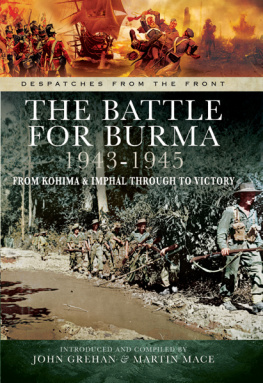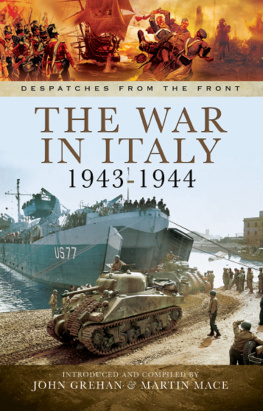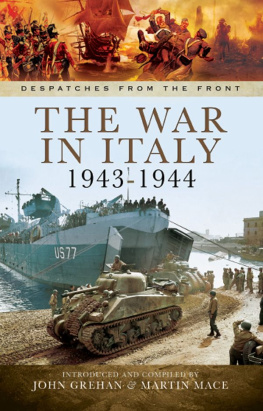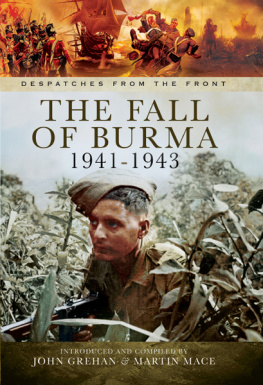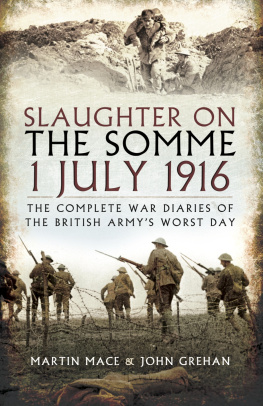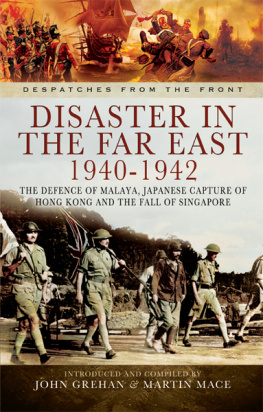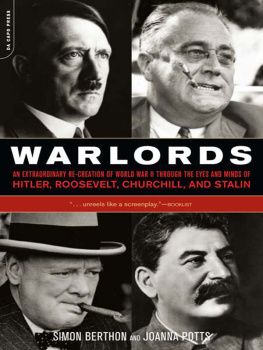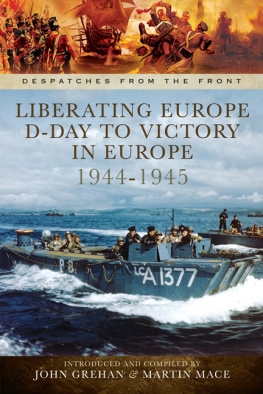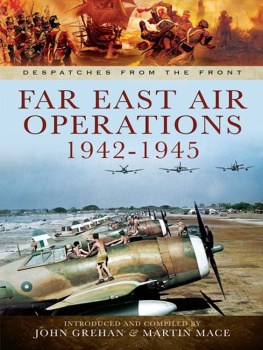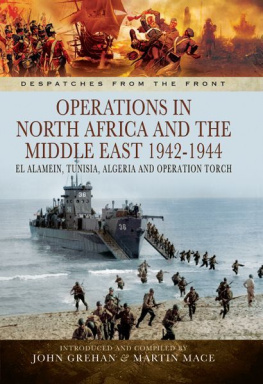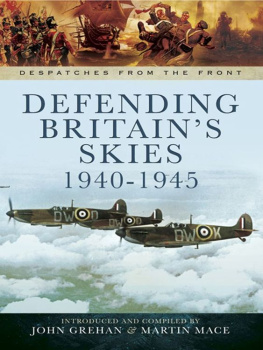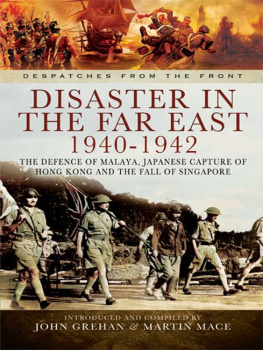First published in Great Britain in 2015 by
PEN & SWORD MILITARY
An imprint of
Pen & Sword Books Ltd
47 Church Street
Barnsley
South Yorkshire
S70 2AS
Copyright John Grehan and Martin Mace, 2015
ISBN: 978-1-78346-199-8
PDF ISBN: 978-1-47386-696-6
EPUB ISBN: 978-1-47386-695-9
PRC ISBN: 978-1-47386-694-2
The right of John Grehan and Martin Mace to be identified as the authors of this work has been asserted by them in accordance with the Copyright, Designs and Patents Act 1988.
A CIP catalogue record for this book is available from the British Library.
All rights reserved. No part of this book may be reproduced or transmitted in any form or by any means, electronic or mechanical including photocopying, recording or by any information storage and retrieval system, without permission from the Publisher in writing.
Typeset by Concept, Huddersfield, West Yorkshire HD4 5JL.
Printed and bound in England by CPI Group (UK) Ltd, Croydon CR0 4YY.
Pen & Sword Books Ltd incorporates the imprints of Pen & Sword Archaeology, Atlas, Aviation, Battleground, Discovery, Family History, History, Maritime, Military, Naval, Politics, Railways, Select, Social History, Transport, True Crime, and Claymore Press, Frontline Books, Leo Cooper, Praetorian Press, Remember When, Seaforth Publishing and Wharncliffe.
For a complete list of Pen & Sword titles please contact
PEN & SWORD BOOKS LIMITED
47 Church Street, Barnsley, South Yorkshire, S70 2AS, England
E-mail:
Website: www.pen-and-sword.co.uk
Contents
Introduction
The achievements of the Allied forces in Burma in 1944 and 1945 have always been overshadowed by the great battles in Europe during that period. It is easy to understand why. The countries of Europe are close by and easily accessible. They are places a great many of people in Britain and the United States have visited; their geography is familiar to us, their languages taught in schools. How different it is with Burma, remote and, until recently, a difficult place to travel to and across.
Yet the war in the Far East was a fascinating one. Not only were the Japanese suicidally courageous, but the Allied troops faced conditions that were completely alien to them and terrain that was almost impassable. That they succeeded is a testament to the planning and training that was undertaken after the British and Commonwealth forces had been driven out of Burma in 1942, as well as the determination of those troops to battle on through the jungle and the monsoons, and overcome the animals and insects and the silent foe which killed and incapacitated so many disease.
It was on 16 November 1943 that the South-East Asia Command was formed to encompass all the military formations in the region. The Army formation within South-East Asia Command was 11 Army Group, whose principal body was the Fourteenth Army. The 11 Army Group was commanded by General Sir George J. Giffard, whose first despatch paints a very clear picture of the country and conditions in which his men had to fight. He also provides an interesting appraisal of the enemy:
The Japanese soldier is fanatically brave when ordered to succeed or die, yet he is liable to panic when surprised or in doubt. His planning is bold yet he is at a loss if plans go wrong. Although most secretive and careful, he will go into action carrying diaries and military papers. He takes infinite pains to conceal his positions and then nullifies the result by talking in them at night. An expert in the use of ground and in silent movement, yet his patrol work is frequently bad. Although bold at infiltrating into, and then rushing a position from an unexpected direction, he becomes easily nonplussed by determined resistance. He is good at laying fixed lines of fire and skilful in the use of snipers, yet he is a bad shot.
As Giffard then explains, whilst the Japanese were still willing to die for the Emperor, this policy of holding their ground regardless of the sacrifice was already, by June 1944, proving to be a poor tactic in many instances where retreat would have been a more sensible option. Slowly the ordinary Japanese were becoming aware of this and some were actually running away or surrendering, something that would have been considered impossible just a few months earlier. The tide was beginning to turn.
Like most conflicts, the fighting in Burma was not conducted in isolation. The Allied offensive that was mounted in South-East Asia in 1944 and 1945 was undertaken with two strategic goals, both of which were beyond the frontiers of Burma. These were, as spelt out by Giffard, the security and improvement of the air ferry route to China and the establishment of land communications with China; and the close and continuous engagement of Japanese land and air forces, so as to cause attrition and diversion from the Pacific Theatre.
Because of the nature of the high mountains and dense jungles, the movement of large bodies of men was always slow. This would make any large-scale deployment of forces difficult and would allow the Japanese the opportunity to block any advance. Before any major operations could be conducted, therefore, a good road, wide enough for two-way traffic had to be built. Giffard provides a highly detailed report on the actions of the Allied forces up to 22 June 1944. The significance of this date is that it marked the end of one of the most decisive battles of the Burma campaign, Kohima. Another battle of even greater significance, the Battle of Imphal, was still raging, though its end was in sight. With these two victories the last attempt by the Japanese to invade India was defeated.
Giffards second despatch continues the story of the Burma campaign up to November 1944. It was a period of almost continuous success as the back of the Japanese Army in Burma had been broken at Kohima and Imphal, particularly in the latter where they had lost more than 50,000 men.
Giffard, understandably, writes his despatch with a triumphal air: The Japanese retreat [from western Burma] began as a well-planned and orderly withdrawal. Gradually, as our pressure grew, the pace of the withdrawal increased until the enemy forces were split up into small, disorganised parties. Hungry, harassed, beaten; abandoning their wounded, their guns and their transport, and even deserting in small, but increasing numbers; the Japanese were driven in defeat over the border, down the far side of the mountain wall, and back over the Chindwin, which they had crossed in triumph and with such high hopes less than five months earlier.
Such observations, however, must not disguise or minimise the experiences of the Allied troops, in effect the Fourteenth Army, fighting their way into central Burma. Battles were fought at 5,000 feet and over, often in almost impenetrable jungle, Giffard wrote, and troops, loaded with full equipment, struggled up from nullahs [steep, narrow valleys] 2,000 feet below in the face of heavy small arms, grenade and mortar fire.
It may be surprising to note that Giffard states that, despite the nature of the ground, it was tanks that often proved the decisive factor, fighting up and down these mountain ranges, where they climbed almost precipitous slopes to blast Japanese bunkers at a range of 10 yards. The Allies continued their advance through the monsoon seasons (two in Burma) that turned tracks into leech-laden streams and chaungs [streams] into treacherous torrents; rain that washed away our already exiguous roads, turned rivers into raging floods.
This despatch is similar in length to Giffards previous one, and together, amounting to almost 50,000 words, they form one of the most detailed accounts of the Burma campaign from the strategic level. One of the subsidiary campaigns undertaken during this period forms the third despatch in this collection. This is the attack upon Ramree Island in January and February 1945, by Vice-Admiral Arthur Power. Once again, the terrain was so inhospitable that Power, like Giffard, was moved to describe it in his despatch: Dark during the day as well as during the night, acres of thick impenetrable forest; miles of deep black mud, mosquitoes, scorpions, flies and weird insects by the billion and worst of all crocodiles.
Next page
